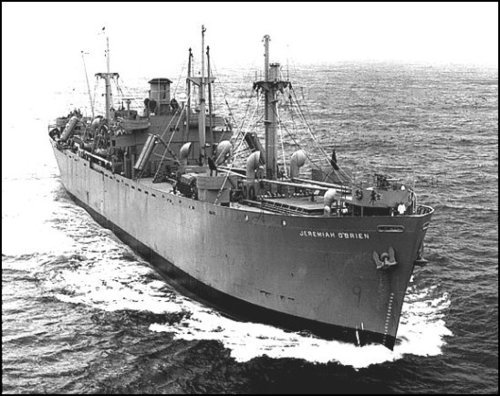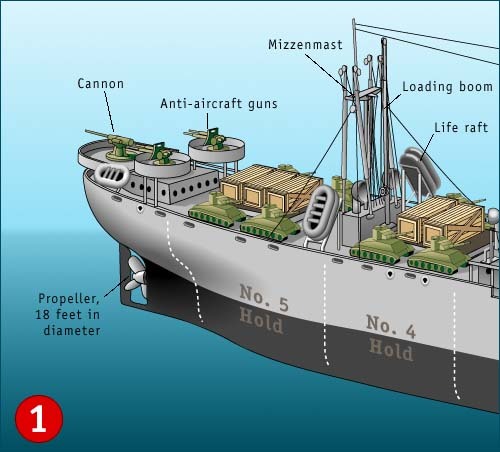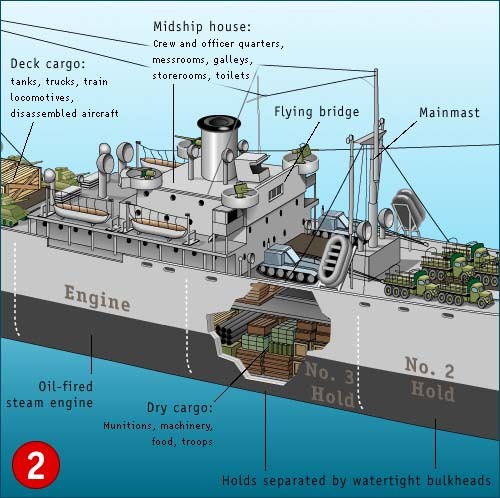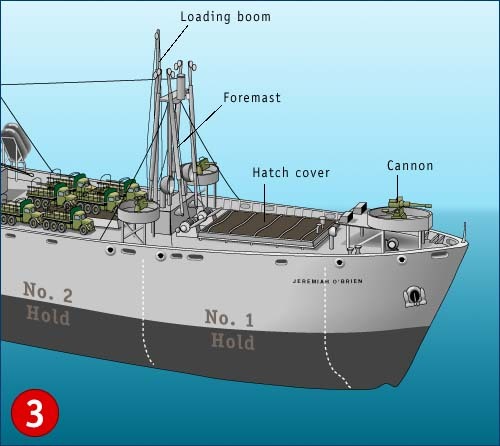Don't wanna be here? Send us removal request.
Text
More on Liberty Ships

Still not convinced on how amazing Liberty Ships were? Many people know about Ford's Model T, and how fast Ford could pump out cars, but few know about the efficiency of Liberty Ships:
"Henry J. Kaiser, who had supervised the Boulder Dam, introduced pre-fabrication to cut the time needed to produce a Liberty-Class merchant ship from six months in 1941 to less than two weeks in 1943, and then just ten days. In 1945 Kaiser, dubbed 'Sir Launchalot,' and other shipbuilders were completing a cargo ship a day." -The Enduring Vision, A History of the American People. Boyer. 6th Edition pg. 798
Liberty ships came in several lengths and though most were designed to carry freight, troops, or fuel, others were modified for a variety of uses, from hospital ships to floating repair shops and Army Tank Transports ("zipper ships"). American Liberty ships were mostly named after notable US citizens and a total of 2,710 were constructed. One was launched 4 days and 15 1/2 hours after her keel was laid.
Of course, there were some downsides. "The speed with which Liberty ships were produced, often by inexperienced workers, resulted in a high percentage of defects and the loss of a number of vessels - one in 30 suffered major fractures... Many were sunk in the *convoys which sustained both countries (US and Britain)."
But hey, when you're pumping out so many ships at a time, who cares?
#6#USA#WW2#WWII#engineering#history#lend lease#liberty ships#manufacture#military#navy#sea#war#1941#1943#1945
1 note
·
View note
Text
Liberty Ships



Mass-produced merchantmen which were constructed in the USA, many by the West Coast Kaiser shipyards. They were described as ships that were "built by the mile and chopped off by the yard".
In September 1940 the British ordered 60 ships from the USA which were based on a British plan for a ship of simple design. To speed up the production of this order these vessels were welded, not riveted, and the original plans were considerably modified by the Americans to take this into account. In January 1941 the USA launched its own emergency construction program of 200 ships based on the modified British design. These 7,126-ton, 11-knot, ships were dubbed "The Liberty Fleet" and 27 September 1941, the day the first one, Patrick Henry, was launched, was called "Liberty Fleet Day", a name which stuck.
4 notes
·
View notes
Text
Baka Bomb



A small rocket-driven plan with a 816 kg (1,800 lb) explosive nose, which the Japanese first used in April 1945 at *Okinawa during the *Pacific war. Baka means 'idiot' in Japanese, and it was so called by the Allies because it was guided on to its target by its suicide pilot. The Japanese called it ohka (cherry blossom) or jinrai (thunderbolt). The parent aircraft which delivered it close to its target was so slow that it was never a serious threat.
1 note
·
View note
Text
Fall Gelb (Operation Yellow):

Codename for the German offensive in the west which started on May 10 1940 and culminated in the fall of *France the following month. Hitler initially employed just under 119 divisions for it and had committed a further 23 by the end of the campaign. In its original form Fall Gelb had the limited aim of destroying a large proportion of the forces which would oppose the German offensive and of gaining access to parts of the Belgian and French coastline to speed the defeat of the UK. Postponements of the offensives - nearly 30 of them from November 1939 onwards - allowed time for the plan, and its aim, to be considerably altered, most notably by *Manstein's plan (Sichelschnitt, or sickle-slice) which meshed with Hitler's growing ambitions. Sichelschnitt envisaged the total destruction of the Allied armies by allotting the main effort (Schwerpunkt) to Army Group A in the south, which advanced through the supposedly impenetrable Ardennes, instead of to Army Group B in the north. As a result, the Allied advance to the *Dyle Line ended in a hasty withdrawal, the *Dunkirk evacuation, and the Fall of France.
0 notes
Text
Rotterdam Raid
Mounted on May 14 1940 to force this Dutch city to capitulate quickly after German paratroopers had previously landed to seize its bridges. The raid was cancelled when surrender discussions started, but the abort message did not reach the aircraft and 57 out of the 100 dropped their bombs before an emergency flare signal was seen. These were aimed at military targets and used no incendiaries, but 2.8km (1.1 sq. mi) of the city centre was destroyed, between 800 and 980 civilians were killed, and a few hours later the Dutch government surrendered with its army still largely intact.
The raid ended the British *phoney war policy of not bombing Germany for the Allies had threatened Germany with retaliation if it bombed civilian targets; and on May 15 1940 the first RAF raid on the Ruhr was launched, heralding the start of the *strategic air offensive against Germany.
0 notes
Text
Washington Convoy Conference:
Planned at the Casablanca conference in January 1943 and held from March 1-12 1943. Present were representatives of the British, Canadian, and US navies, and the RAF and USAAF Anti-Submarine Command, who made various recommendations to the *Combined Chiefs of Staff. To the surprise of the British and Canadians it soon became apparent that the Americans wanted to withdraw their escort vessels from the battle of the *Atlantic. A compromise was reached by which the British and Canadian navies took complete control of northern transatlantic *convoys, except for the short leg between Halifax and Boston or New York. As part of this reorganization, Rear-Admiral *Murray headed a newly formed North-West Atlantic Command during the final phase of the battle of the Atlantic. The conference also decided that 20 very-long-range aircraft be supplied to the Royal Canadian Air Force to start covering the principal mid-Atlantic *air gap south of Greenland. It was also agreed that new convoy cycles be set up; the *huff-duff network be increased; escort carrier groups be introduced to protect Atlantic convoys.
1 note
·
View note